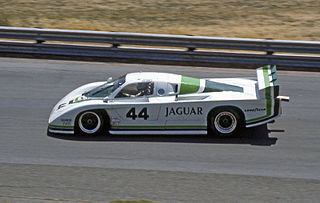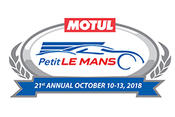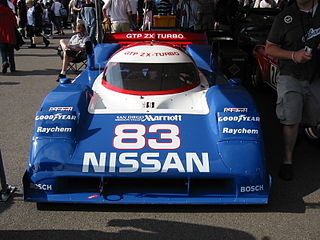Related Research Articles

The 24 Hours of Daytona, also known as the Rolex 24 At Daytona for sponsorship reasons, is a 24-hour sports car endurance race held annually at Daytona International Speedway in Daytona Beach, Florida. It is run on the Sports Car Course layout, a 3.56-mile (5.73 km) combined road course that uses most of the tri-oval plus an infield road course. Held on the last weekend of January or first weekend of February as part of Speedweeks, it is the first major automobile race of the year in North America. The race is sanctioned by IMSA and is the first race of the season for the IMSA SportsCar Championship.

The 12 Hours of Sebring is an annual motorsport endurance race for sports cars held at Sebring International Raceway, on the site of the former Hendricks Army Airfield World War II air base in Sebring, Florida, US. In the past, this race has been a round of the now defunct World Sportscar Championship, IMSA GT Championship and American Le Mans Series. In 2012, the race was the opening event of the FIA World Endurance Championship in a one off race before being returned to the American Le Mans Series for 2013. Starting in 2014, the event became the second round of the WeatherTech SportsCar Championship.
Brian Herman Thomas Redman is a British retired racing driver.

The North American Racing Team (NART) is a motorsport racing team founded in 1958. It was created by businessman Luigi Chinetti to promote the Ferrari marque in North America through success in endurance racing.

Bill Adam is a Canadian racing driver born in Airdrie, North Lanarkshire, Scotland.
John Lee Paul Jr. was an American racing driver. He competed in CART and the Indy Racing League competitions, but primarily in IMSA GT Championship, winning the title in 1982.

Joest Racing is a German sports car racing team that was established in 1978 by former Porsche works racer Reinhold Joest. Their headquarters are in Wald-Michelbach, Germany.
Wayne Taylor is a South African sports car racing driver and team owner. He won the 1996 and 2005 24 Hours of Daytona, and the 2005 Grand-Am Rolex Sports Car Series Daytona Prototype drivers' championship. He drove for SunTrust Racing with Max Angelelli. He co-drove in the 2006 International Race of Champions in the United States with Angelelli. Taylor now owns and manages his own team competing in the WeatherTech SportsCar Championship.
Dyson Racing is a professional sports car racing team based in Poughkeepsie, New York in the United States. Founded by Rob Dyson in 1974, the team competed successfully in North American sports car racing series, including the IMSA GT Championship and American Le Mans Series.

IMSA GT was a sports car racing series organized by International Motor Sports Association. Races took place primarily in the United States and occasionally in Canada.
Risi Competizione is an Italo-American auto racing Ferrari factory-backed team formed by Giuseppe Risi in 1997. Initially, the team had a partnership with Doyle Racing using the name Doyle-Risi Racing, but soon Giuseppe Risi took full control of the project and it was rebranded with its current name in 2000. Risi Competizione has won races and championships in the IMSA GT championship, American Le Mans Series, and Rolex Sports Car Series, as well as earning three class wins at the 24 Hours of Le Mans in 1998, 2008 and 2009. Much of Risi Competizione's success has come through the use of Ferrari machines.

Daniel Morad is a Canadian racecar driver and YouTuber who currently competes in IMSA for Winward Racing in a Mercedes AMG GT3 in the GTD Class. He is notable for winning the 2007 American Formula BMW championship; the 2010 World Championship in the Rotax Max Challenge Grand Finals in La Conca, Italy; the 2016 Ultra 94 Porsche GT3 Cup Platinum Cup; and the 2017 Rolex 24 Hours of Daytona with Alegra Motorsports.

Petit Le Mans is a sports car endurance race held annually at Road Atlanta in Braselton, Georgia, United States. The race has been held for a duration of 10 hours since 2014, having previously been held for either 1,000 miles (1,600 km) or 10 hours, whichever came first. In addition to the overall race, teams compete for class victories in different categories, divided into prototypes and grand tourers.
The Argo P was a sports prototype racing car, built by Argo Racing Cars in 1997 for the IMSA GT Championship. The car used a naturally-aspirated 4-litre BMW V8 engine throughout its racing life. The car proved to be uncompetitive, and its fastest race laps were frequently well off the pace of the other runners.
The Mazda GTP is an IMSA GTP race car that was built by Pierre Honegger in 1981. Based on a Mazda RX-7, the car initially competed in the GTX category as the Mazda RX-7 GTP, before it was rebuilt for the IMSA GTP category in 1983. Throughout its career, the car used a Mazda 13B Wankel rotary engine, similar to that used in the production RX-7s. Although the rotary-engined sports prototypes generally had a reputation of being very reliable, the Mazda GTP frequently failed to finish races, and was never able to better the eighth place achieved at the 1983 24 Hours of Daytona. In 1986, one car was purchased by Erie Scientific Racing, and rebuilt to become the Badger BB. This car was no more successful or reliable than its predecessor, and was last used in 1989, by which point it was owned by Jack Engelhardt. The other car, meanwhile, was rebuilt by Honegger into the Denali Speedcar, which was used with moderate success in 1986 and 1987.

The Nissan Present the 39th Annual 12 Hours of Sebring International Grand Prix of Endurance, was the third round of both the 1991 Camel GT Championship and Exxon Supreme GT Series and was held at the Sebring International Raceway, on 16 March.
The Hawk MD3R is a Le Mans Prototype mid-engine, rear-wheel drive race car chassis raced between 1994 and 1995 and 1997 and 2001, on tracks such as Daytona International Speedway, Sebring, and Laguna Seca. It is often complemented by Mazda engines, such as the 2.0 L 3-Rotor, however it has also been raced with a Chevrolet engine The vehicle has been run most frequently by Support Net Racing Inc., Team South Carolina and Genesis Racing

The Courage C41 was a sports prototype racing car built by Courage Compétition in 1994, and used in international sports car races from 1995 until 1999. Designed by Paolo Catone, it initially used a 5-litre Chevrolet V8 engine, developed by Comptech, and later used the 3-litre twin-turbocharged flat-six engine from a Porsche 935, as well as an Oldsmobile V8. In 1998, two of the C41s were developed into the Courage C51, which used a 3-litre twin-turbocharged Nissan VRH35Z V8 engine, and was used in that year's 24 Hours of Le Mans. In 1999, the C41s were mostly converted to the C52 specification ; this initially used a 3.5-litre twin-turbocharged Nissan VRH35L V8, which was then replaced by a 3.2-litre twin-turbocharged Peugeot A32 V6 engine for 2000. In 2000, the C41 line was replaced by the new C60.

The March 86G was a Group C and IMSA GTP sports racing car built by March Engineering. Built as simply a chassis with no engine, it was branded as one of three cars, the BMW GTP, the Buick Hawk or the Nissan R86V depending on which engine was placed in the chassis and which team was running it. There were a number of subtle bodywork changes to reflect the manufacturer which ran the car.

Frederic Barry Opert, known as "Fred", was an American racing driver, car dealer, and founder and owner of the Fred Opert Racing team.
References
- ↑ "Chevron" . Retrieved October 30, 2022.
- ↑ "Chevron B71" . Retrieved October 30, 2022.
- ↑ "Analogue Racing - DoubleDeClutch.com". www.doubledeclutch.com.
- ↑ "Keiler KII" . Retrieved October 30, 2022.
- ↑ "Keiler KII" . Retrieved October 30, 2022.
- ↑ Development, PodBean. "MP 249: Strangest Cars I've Raced, Owen Trinkler, 1997 Keiler Kopf WSC". marshallpruett.podbean.com.
- ↑ "1998 Keiler K II - FORD V8 THUNDER - ERL 2022 Spa & Le Mans" – via www.youtube.com.
- ↑ "Daytona 24 Hours 1995 - Race Results - Racing Sports Cars". www.racingsportscars.com. Retrieved January 7, 2025.
- ↑ "12 Hours of Sebring". www.ultimateracinghistory.com. Retrieved January 7, 2025.
- ↑ "Road Atlanta 3 Hours 1995 - Race Results - Racing Sports Cars". www.racingsportscars.com. Retrieved January 7, 2025.
- ↑ "Laguna Seca IMSA WSC 1997 - Race Results - Racing Sports Cars". www.racingsportscars.com. Retrieved January 7, 2025.